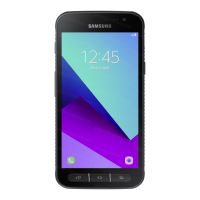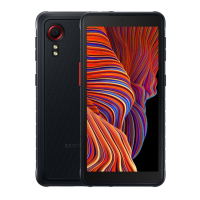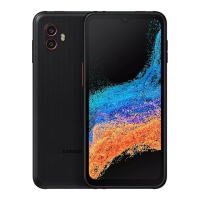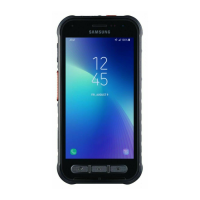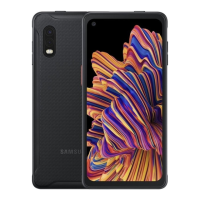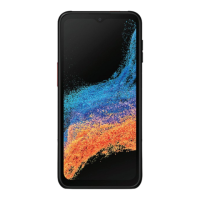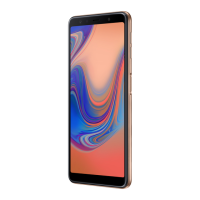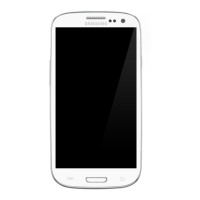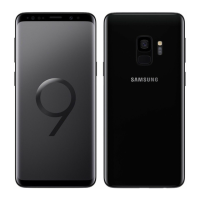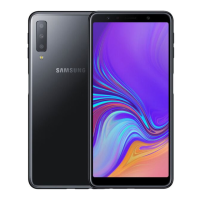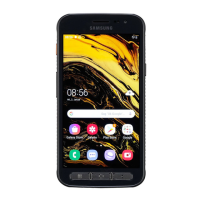
Do you have a question about the Samsung Galaxy XCover 4s and is the answer not in the manual?
| Panel type | TFT |
|---|---|
| Screen shape | Flat |
| Pixel density | 294 ppi |
| Display diagonal | 5 \ |
| Touch technology | Multi-touch |
| Touchscreen type | Capacitive |
| Display resolution | 720 x 1280 pixels |
| Native aspect ratio | 16:9 |
| Display number of colors | 16 million colors |
| Processor cores | 6 |
| Processor family | Samsung Exynos |
| Coprocessor cores | 2 |
| Processor frequency | 1.6 GHz |
| User memory | 21.2 GB |
| RAM capacity | 3 GB |
| Compatible memory cards | MicroSD (TransFlash) |
| Maximum memory card size | 512 GB |
| Internal storage capacity | 32 GB |
| Flash type | LED |
| Rear camera type | Single camera |
| Maximum frame rate | 30 fps |
| Video recording modes | 1080p |
| Rear camera aperture number | 1.7 |
| Front camera aperture number | 2.2 |
| Video capture resolution (max) | 1920 x 1080 pixels |
| Rear camera resolution (numeric) | 16 MP |
| Front camera resolution (numeric) | 5 MP |
| 4G standard | LTE |
| 2G standards | GSM |
| 3G standards | UMTS, WCDMA |
| SIM card type | NanoSIM |
| Wi-Fi standards | 802.11a, 802.11b, 802.11g, Wi-Fi 4 (802.11n), Wi-Fi 5 (802.11ac) |
| Bluetooth version | 5.0 |
| 3G bands supported | 850, 900, 1900, 2100 MHz |
| 4G bands supported | 700, 800, 850, 900, 1800, 2100, 2300, 2600 MHz |
| SIM card capability | Dual SIM |
| 2G bands (primary SIM) | 850, 900, 1800, 1900 MHz |
| Mobile network generation | 4G |
| Subscription type | No subscription |
| USB connector type | USB Type-C |
| Headphone connectivity | 3.5 mm |
| Multimedia Messaging Service (MMS) | Multimedia Messaging Service (MMS) is a standard way to send messages that include multimedia content to and from a mobile phone over a cellular network |
| Form factor | Bar |
| Product color | Black |
| Protection features | Dust resistant, Water resistant |
| International Protection (IP) code | IP68 |
| Themes | Wallpapers |
| Personalization | Icons, Menu, Shortcuts |
| Military standard | MIL-STD-810G |
| Wireless charging | No |
| Personal info management (PIM) | Alarm clock, Calculator, Calendar, Events reminder, Notes, To-do list |
| Platform | Android |
| Google applications | Google Maps, Google Play |
| App distribution platform | Google Play |
| Operating system installed | Android 9.0 |
| Cables included | USB |
| Talk time (3G) | 23 h |
| Battery capacity | 2800 mAh |
| Standby time (3G) | - h |
| Browsing time (4G) | 14 h |
| Continuous audio playback time | 59 h |
| Continuous video playback time | 13 h |
| Audio formats supported | 3GA, AAC, AMR, AWB, FLAC, IMY, M4A, MID, MIDI, MP3, MXMF, OGA, OGG, OTA, RTTTL, RTX, WAV, WMA, XMF |
| Video formats supported | 3G2, 3GP, ASF, AVI, FLV, M4V, MKV, MP4, WEBM, WMV |
| Body SAR (EU) | 1.307 W/kg |
| Head SAR (EU) | 0.905 W/kg |
| Depth | 9.7 mm |
|---|---|
| Width | 73.3 mm |
| Height | 146.2 mm |
| Weight | 172 g |
Identifies the Samsung device model SM-G398FN.
Important safety, usage, water/dust resistance, and instructional icon information.
Explains causes of overheating and provides solutions and precautions.
Details the physical components and buttons of the device.
Covers charging, installing/removing battery, and reducing consumption.
Guides for inserting SIM/USIM cards and microSD cards.
Instructions for turning the device on/off and initial setup.
Covers camera operation, modes, settings, and customization options.
Managing Samsung account and transferring data using Smart Switch.
Understanding touchscreen, navigation bar, and Home screen customization.
Managing notifications, indicator icons, text input, and copy/paste.
Installing/uninstalling apps, phone calls, contacts, and message handling.
Covers searching, deleting, sharing, grouping contacts and message handling.
Using Internet, Email, Gallery for media viewing and management.
Using Multi window, Samsung Health, and other productivity apps.
Using Samsung Notes, Reminders, Voice Recorder, Clock, and Calculator.
Managing games with Game Launcher/Booster, SmartThings, Smart View, and sharing.
Overview of Google apps and setting up Samsung Kids mode.
Using the Radio app and taking screenshots.
Configuring Samsung account, Wi-Fi, Bluetooth, NFC, Hotspot, and printing.
Adjusting sounds, notifications, display settings, wallpaper, and themes.
Managing lock screen, biometrics, Secure Folder, privacy, and location.
Backing up data, using advanced features, and managing device usability.
Digital wellbeing, battery care, storage, general management, accessibility, and software updates.
Solutions for device problems, including network, audio, battery, camera, and connectivity.
